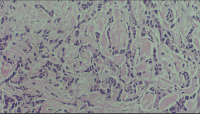Clinical and Pathological Presentations of Breast Cancer among Young Women in North-Central Nigeria
Main Article Content
Abstract
INTRODUCTION: Breast cancer in the young is rare. Breast cancer in young women seems to be on the rise in Nigeria. They present within the peak of reproductive years and career. They have more aggressive disease with a worse prognosis. Treatment is based on knowledge of treatment of older women. There are very scanty data on breast cancer in the young in our environment. This study
aims to highlight the clinical stage of presentation and histological subtypes among women below 40.
PATIENTS AND METHODS: This is a prospective study done over 2 years. The patients' sociodemographic data, clinical staging and histological diagnosis were noted.
RESULTS: A total of 112 cases of breast cancer were seen, out of which 58 (51.75%) cases were aged below 40 years. Forty patients (68.9%) cases had Stage IV disease, 12 (20.68%) of the cases had Stage III, five (8.62%) had Stage II and one patient had Stage I (1.72%). Out of the 40 who were Stage IV, three were pregnant in the third trimester. Histology was invasive ductal carcinoma for 48 (84.4%) cases, while nine (15.52%) were invasive lobular cancer and one was medullary carcinoma (1.72%). Hormone and immunohistochemistry showed that 30 (51.7%) were triple‑negative, 22 (37.93%) were oestrogen receptor and progesterone receptor+ and six (10.34%) were human epidermal growth factor+.
CONCLUSION: More than half of the total cases of breast cancer seen within the period were young women who presented with late stage of the disease with the majority as triple‑negative.
Downloads
Article Details

This work is licensed under a Creative Commons Attribution-NonCommercial-ShareAlike 4.0 International License.
References
American Cancer Society. Breast Cancer Facts & Figures 20092010. Atlanta: American Cancer Society, Inc. 2010.
Althuis MD, Brogan DD, Coates RJ, Daling JR, Gammon MD, Malone KE, et al. Breast cancers among very young premenopausal
women (United States). Cancer Causes Control 2003;14:151‑60
Winchester DP, Osteen RT, Menck HR. The national cancer data base report on breast carcinoma characteristics and outcome in relation to age. Cancer 1996;78:1838‑43.
Anders CK, Hsu DS, Broadwater G, Acharya CR, Foekens JA, Zhang Y, et al. Young age at diagnosis correlates with worse prognosis and defines a subset of breast cancers with shared patterns of gene expression. J Clin Oncol 2008;26:3324‑30.
Nixon AJ, Neuberg D, Hayes DF, Gelman R, Connolly JL, Schnitt S, et al. Relationship of patient age to pathologic features of the tumor and prognosis for patients with stage I or II breast cancer. J Clin Oncol 1994;12:888‑94.
Colleoni M, Rotmensz N, Robertson C, Orlando L, Viale G, Renne G, et al. Very young women (<35 years) with operable breast cancer: Features of disease at presentation. Ann Oncol 2002;13:273‑9.
Sabiani L, Houvenaeghel G, Heinemann M, Reyal F, Classe JM, Cohen M, et al. Breast cancer in young women: Pathologic features and molecular phenotype. Breast 2016;29:109‑16.
Passhak M, Shachar SS, Bar‑Sela G, Fried G. Breast cancer in young women aged 35 and under: Patterns of care and outcome. Breast
J 2018;24:441‑3.
Greally M, Kielty J, Watson GA, Das G, Malouf C, McSorley L,et al. Where youth matters – Clinicopathologic characteristics and emerging trends in treatment and outcomes in young Irish women with breast cancer. Ir J Med Sci 2019;188:59‑67.
de Azambuja E, Holmes AP, Piccart‑Gebhart M, Holmes E, Di Cosimo S, Swaby RF, et al. Lapatinib with trastuzumab for HER2‑positive early breast cancer (NeoALTTO): Survival outcomes of a randomised, open‑label, multicentre, phase 3 trial and their association with pathological complete response. Lancet Oncol 2014;15:1137‑46.
Copson E, Eccles B, Maishman T, Gerty S, Stanton L, Cutress RI,et al. Prospective observational study of breast cancer treatment outcomes for UK women aged 18–40years at diagnosis: The POSH study. J Natl Cancer Inst 2013;105:978‑88.
Gnerlich JL, Deshpande AD, Jeffe DB, Sweet A, White N, Margenthaler JA. Elevated breast cancer mortality in women younger than age 40 years compared with older women is attributed to poorer survival in early‑stage disease. J Am Coll Surg 2009;208:341‑7.
Chen HL, Zhou MQ, Tian W, Meng KX, He HF. Effect of age on breast cancer patient prognoses: A population‑based study using the SEER 18 database. PLoS One 2016;11:e0165409.
Jayasinghe UW, Taylor R, Boyages J. Is age at diagnosis an independent prognostic factor for survival following breast cancer? ANZ J Surg 2005;75:762‑7.
Gajdosc C, Tartter PL, Bleweiss IJ. Stage 0 to stage 111 breast cancer in young women. J Am Coll Surg 2000;190:525‑9.
Foxcroft LM, Evans EB, Porter AJ. The diagnosis of breast cancer in women younger than 40. Breast 2004;13:297‑306.
Ihemelandu CU, Leffall LD Jr., Dewitty RL, Naab TJ, Mezghebe HM, Makambi KH, et al. Molecular breast cancer subtypes in premenopausal and post menopausal African‑American women: Age specific prevalence and survival. J Surg Res 2007;143:109‑18.
Boyages J, Recht A, Connolly JL, Schnitt SJ, Gelman R, Kooy H,et al. Early breast cancer: Predictors of breast recurrence for patients treated with conservative surgery and radiation therapy. Radiother Oncol 1990;19:29‑41.
Ntekim A, Nufu FT, Campbell OB. Breast cancer in young women in Ibadan, Nigeria. Afr Health Sci 2009;9:242‑6.


